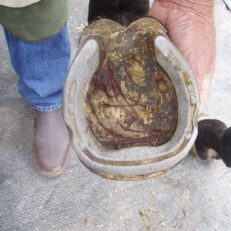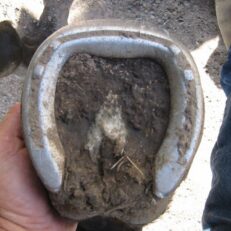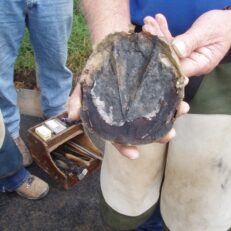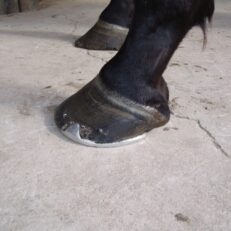I had a call from a client tonight. I have only recently taken over her horses, and when I did so she had them in square toed shoes. I told her what I thought of square toed shoes and what I said was the same as I have said in recent articles – I will use square toed shoes when I find a horse with a square coronary band. As I have also said in recent articles, square toed shoes are a very lazy and short cut way of shoeing a horse which has an over-reach problem. All that is required is to balance the hoof correctly. I convinced this new client to let me shoe the horse in the correct fashion and she was dubious at first, but delighted with the improved results.
Tonight’s call from her was to tell me that the horse was forging after being shod only three weeks ago. Forging is caused when the toe grows too long , slowing down the break over or take off of the front hoof thus causing the rear hoof to collide with the heel of the front hoof. This excessive toe growth is usually conformation-related to long sloping pasterns, and is undoubtedly the reason why so many horses are put into rolled or square toed shoes, which is a big mistake. Nature is telling us that these horses need to be re-shod more often than just six weekly, in order to maintain the correct hoof pastern angle and symmetrical shape.
Rolled or square toed shoes will speed up these front feet but they also drastically alter the flight of the hoof causing them to lift higher but land shorter thus causing jarring up the legs. This concussion actually retards the hoof growth also, and when the hoof is re-balanced it begins to then grow at an accelerated rate for some time; nature’s relief I guess.
This is a very interesting progression, and is one that I have noticed repeatedly when taking horses out of square toed shoes and then balancing the hoof and using a shoe to suit the horse and a shoe which is the same shape as the ideal coronary band.
The reason is that when the hoof is balanced, the hoof capsule is evenly supported and the weight of the horse is evenly distributed. This allows the hoof capsule to work evenly on all contact points.
So the real problem in the first place was that the assessment of the horse’s hoof pastern angle was not given enough consideration in programming his re-shoeing periods, which then allowed the toes to get too long which also causes the low heel syndrome as well. My experience with these horses has shown that if the front feet are re-shod every three or four weeks to keep this toe growth in check, the low heels will start growing again and after a while they develop a healthy heel buttress.
However, it does take some diplomatic persuasion to convince the owner that they have to join in with the hoof care programme seriously.




